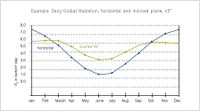SPIS Toolbox - Specifics of Solar Energy

| ►Back to the Start Page | ►Back to the Module Page | ►Go to the Next Chapter |
1.2 Specifics of Solar Energy
Solar radiation
Solar energy has some specific characteristics that must be considered when planning a Solar Powered Irrigation System. Solar radiation captured by a solar panel is never constant due to daily and seasonal variations of solar radiation. The intensity of solar radiation on a surface is called irradiance (S). The irradiance is measured in watts per square meter [W/m²].
Solar irradiance varies over the course of the day, with maximum values of about 1,000 W/m² on a horizontal surface at sea level around noon on a clear day. The energy carried by radiation on a surface over a certain period of time is called global solar radiation (G). The global solar radiation is location-specific as it is influenced by cloud, air humidity, climate, elevation and latitude, etc. The global solar radiation on a horizontal surface is measured by a network of meteorological stations all over the world and is expressed in kilowatt hours per square meter [kWh/m²].
Tilt angle
Most solar panels are installed with a fixed tilt angle “α” to increase the energy yield. Tilt angle is site-specific and has to be calculated. This can easily be done with the help of software tools such as the meteorological data base METEONORM, which provides climate data for almost every location in the world. A quick estimate of the right tilt angle α can be established when looking at the latitude in which the pumping system is installed.
Typical values for the tilt angle can be estimated to:
α = absolute value of geographic latitude + / - 10º
To allow rain water and accumulated dust to run off the panel surface, the tilt angle should be at least 15°, even if the system is installed close to the equator. To focus the applications in winter months, the tilt angle might be increased up to +10º, for summer months, the tilt angle might be reduced up to -10º.
Orientation of the solar generator
In the northern hemisphere, the panels should be facing south to maximize the energy yield, whereas in the southern hemisphere, panels should be facing north. Deviations from true north/south are possible but will result in a reduced overall energy yield.
Another method to further increase the energy yield of a solar generator is solar tracking (see Chapter 2).
| ►Back to the Start Page | ►Back to the Module Page | ►Go to the Next Chapter |





















